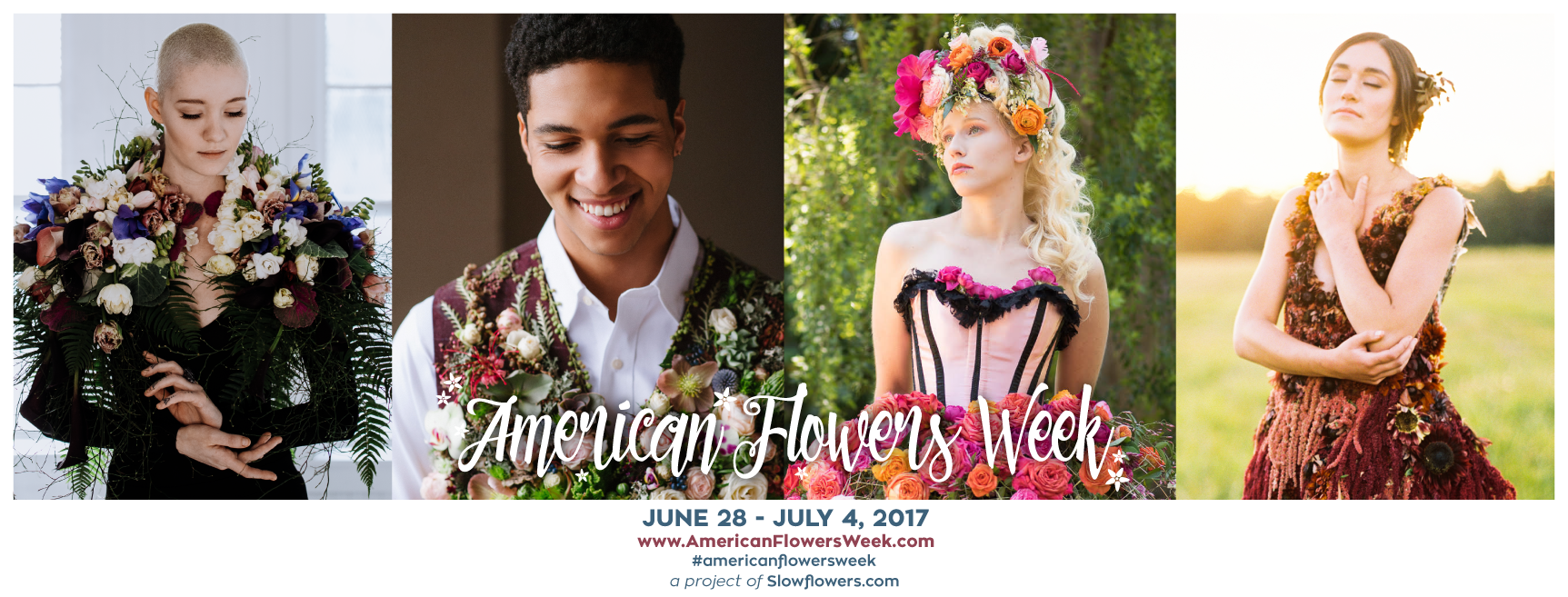AMERICAN-GROWN FLORAL FASHION
30 Friday Jun 2017
In Year Three, American Flowers Week Salutes Iconic U.S.-Grown Flowers and Foliages with a Couture Approach
*Note: This essay originally published in Florists’ Review June 2017 edition.
Photography credits: Anna Peters, Mary Grace Long, Jillian and Ryan McGrath, John Kaemmerling
In 2015, while in London for the Chelsea Flower Show, I met with Helen Evans, one of the geniuses behind New Covent Garden Market’s successful British Flowers Week campaign (June 19-25, 2017).
The U.K.’s most important wholesale floral hub launched BFW in 2013 as a low-budget, social media-driven “annual celebration of seasonal, locally-grown flowers and foliage united the U.K. cut flower industry and sparking public and media interest in where our flowers come from.” It has become a popular and successful campaign to promote British flowers — and floral designers.
By the time we had finished sipping from our steaming mugs of tea in the Market’s employee break room, I was thinking to myself: “I should start American Flowers Week.”
Helen and her colleagues were immensely helpful and supportive. I returned to the U.S. in late May 2015 inspired by the BFW model, equipped with Helen’s suggestions and resources, and by the end of June, I introduced American Flowers Week.
It seems entirely fitting that our week coincides with Independence Day, July 4th. Not only do these dates provide a patriotic hook on which to hang AFW, the timing is perfect because there are local flowers growing on farms in all 50 U.S. states, Alaska included, in late June and early July. And, as one wholesale floral manager suggested: “It’s otherwise a down time in floral, so we love having a new event to help promote flowers.”
The initial grass-roots endeavor enjoyed 400,000 social media impressions during the 2015 campaign.

Susan McLeary of Passionflower Events created our red-white-and-blue floral ‘fro for 2016, with graphic design from Jenny Diaz
In 2016, we added beautiful collateral material, a free USA floral coloring map that participating florists and flower farmers could download and share with customers, and even red-white-and-blue stickers used by florists, flower farmers and retailers to label their AFW bouquets. Impressions on social media hit 1.3 million last year.

This year’s campaign graphic features Floral Fashion by Amy Kunkel-Patterson of Gather Design Co., photography by Anna Peters, and graphic design by Jenny Diaz — read the entire story tomorrow!
I can’t wait to see what we’ll reach for 2017. This is Day Two of American Flowers Week and we’ve already hit 2.0 million impressions on Twitter & Instagram alone! That’s radical! Love how the Slow Flowers Tribe is helping make American Flowers Week a *trending topic!
For 2017, I’ve borrowed yet another page from British Flowers Week. BFW selects five iconic U.K.-grown flowers and pairs each with a high-profile florist or design team to produce installations and vignettes. The press and online media devour these images — and of course, the publication of them creates a buzz about British flowers and the farmers and florists who supply them.
Slow Flowers, which presents AFW, has commissioned five floral-inspired fashion shoots depicting iconic American grown blooms. The designers who contributed their creativity and artistic talents teamed up with generous flower farms that donated stems straight from their fields and greenhouses.
The goal? To showcase domestic and seasonal flowers in a new and engaging way — and to show how inventiveness and ingenuity, along with American grown flowers, produce beautiful results.
These All-American floral looks would never have been possible without the support of Slow Flowers’ sponsors, including Certified American Grown, Arctic Alaska Peony Cooperative, Longfield Gardens, Syndicate Sales, Seattle Wholesale Growers Market, Johnny’s Selected Seeds and Association of Specialty Cut Flower Growers.
Upcoming: For the next 5 days — through July 4th — I’ll post the story of each Floral Fashion, with insights from its designer, as well as flower farmers who provided the botanicals incorporated in each wearable style.








One Comment